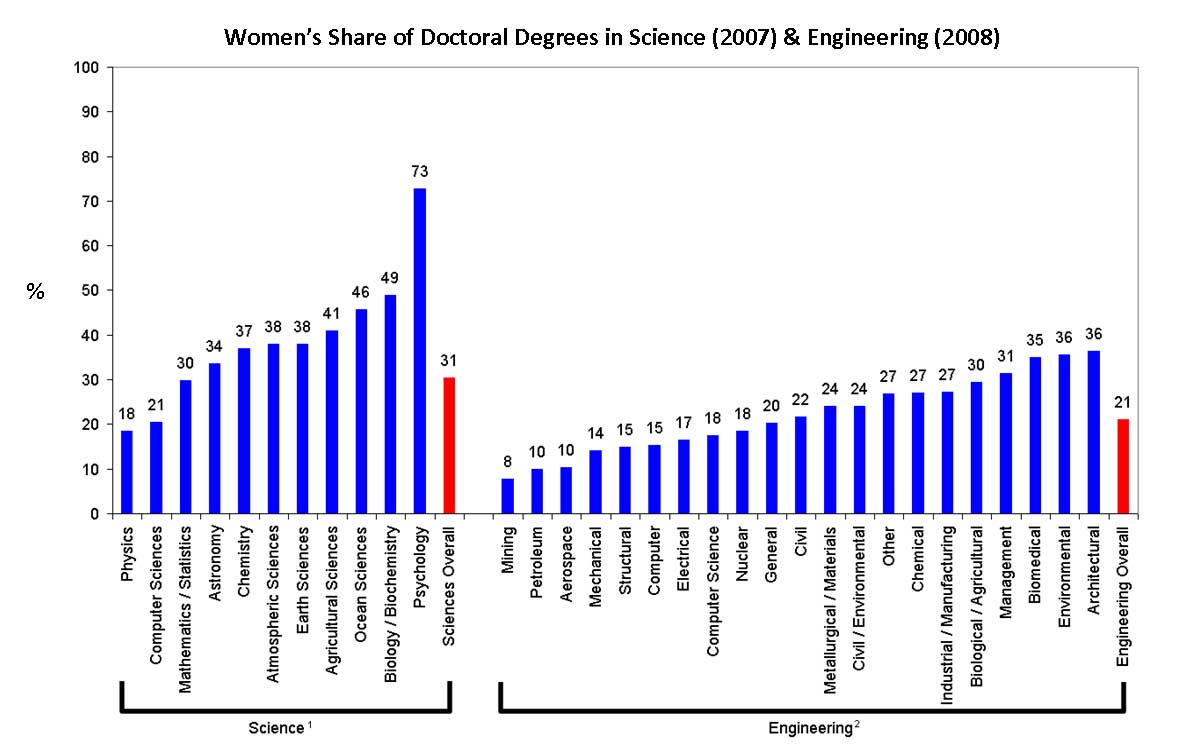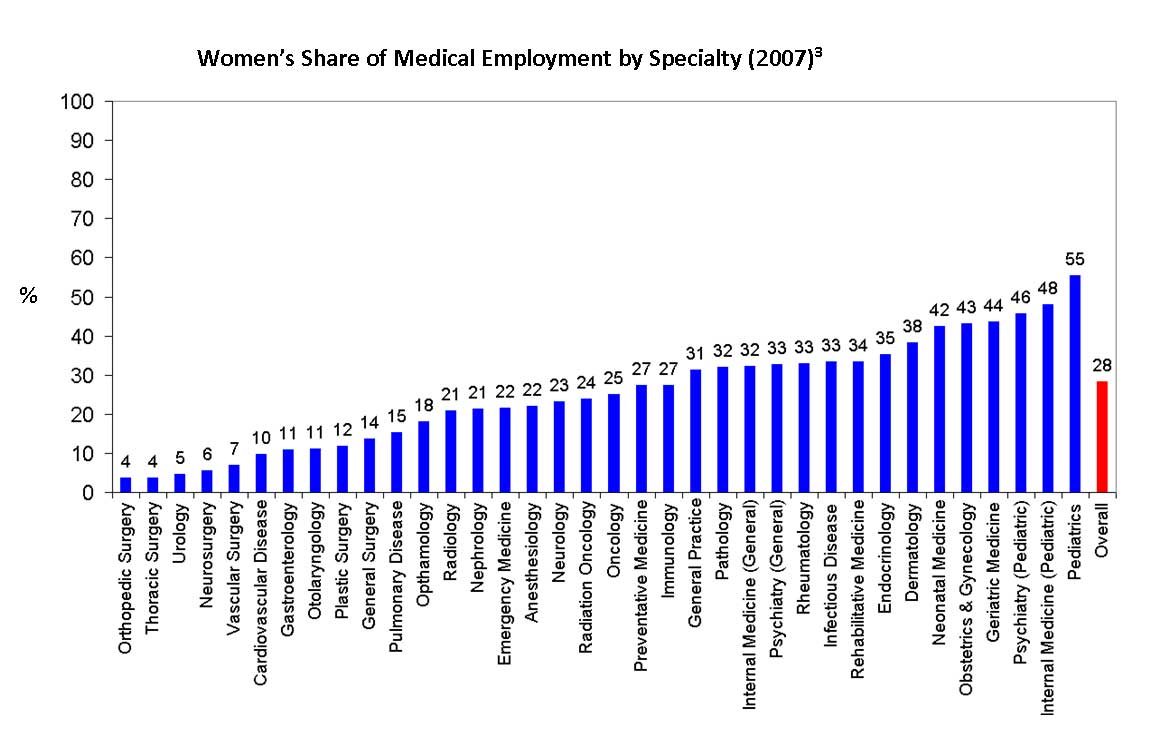Academic disciplines divide human knowledge into manageable endeavors. Disciplines have developed over the past two hundred years when women were stringently excluded from the academy (Schiebinger, 1989). Gendered innovations requires us to consider the possibility that human knowledge—what we know, what we value, what we consider important, and how we configure disciplines—may change dramatically as women become full partners in knowledge production.
Data suggest the following trends:
1. Women hold appointments across disciplines
Women tend to hold interdisciplinary appointments, that is to say they tend not to “fit” in traditional departments. A study at the University of California, Berkeley, for example, found that 26% women vs. 15% men hold inter-departmental appointments. A study of universities in the UK showed that women researchers engaged in interdisciplinary project more often than men across all fields (humanities, social science, natural science) (HEFCE,1999).
2. Women cluster in certain disciplines
Women cluster in the life and behavioral sciences (see chart below). Overall, women make up 49% of Ph.D.s in the biological sciences (NSF, 2008). Women’s participation is high in psychology, biology, oceanography, earth sciences, environmental, agricultural, and biomedical engineering.
Fewer women are found in the physical sciences or in mechanical or electrical engineering. They make up only 30% of Ph.D.s in the physical sciences and 21% in engineering overall (NSF, 2008). Men’s numbers are especially high in mining engineering, petroleum sciences, aerospace, physics, and computer science (see chart below).


3. New interdisciplinary fields are attractive to women
Bioengineering, one of the newer departments at Berkeley, has 50% women on faculty (National Academies, 2006). A NSF PI in an IGERT study (NSF’s interdisciplinary training program) noted that he had long tried to recruit more female students into the engineering department but that it was not until he implemented a program in bioengineering that he succeeded. Connection to life sciences increased the overall pool of female applicants (Rhoten et al., 2007).
4. Women engage in research that takes on visible and compelling social goals
A number of studies from the 1990s found that women enter science and engineering with a desire to improve people’s quality of life whether in terms of health or well-being (Rosser, 2000). Studies in the 2000s found that women are concerned with understanding the environmental and health impacts of scientific projects. They engage in research that is socially relevant and serves human needs.
5. Disciplines have distinctive cultures, or shared professional identities
Disciplines have distinctive identities that mirror the values and gender traits of their founders—people who established the field, defined its goals, and research methods. These cultures determine, at least in part, new recruits to the field and what type of knowledge is produced. In archaeology and associated fields such as anthropology and geology, for example, field work and excavation are primary forms of data acquisition and also of professional identity formation. Archaeologist Stephanie Moser argues that fieldwork molds archaeologists’ value and distinctive behaviors. It represents a kind of initiation ritual and tends to romanticize a sense of adventure, discovery, freedom, survival, and “going where no ‘man’ has gone before.” This emphasis on exotic outdoor settings, hardship, physicality, and strength has cultivated a disciplinary identity that is difficult for women to “master” (Moser, 2007). Astrophysicist C. Megan Urry makes a similar argument about physics, namely that the culture molds values that have an impact on who becomes a physicist (Urry, 2008).
6. Relation of academic disciplines to knowledge
Disciplinary cultures mediate between professionals and the knowledge they produce. Ellen Messer-Davidow, David Shumway, and David Sylvan have shown that what counts as science results in part from disciplines producing their own “economies of value,” manufacturing their own discourse, regulating jobs, divvying up funding, conferring and guarding prestige (Messer-Davidow et al., 1993). Much that has not counted as "science," such as home economics and nursing, has been associated with women's work. It is important to analyze who determines what counts as science, by what criteria, and within which historical contexts.
Example: The rise and fall of Home Economics. The University of California at Berkeley created a Department of Home Economics in 1905. Headed by organic chemist, Agnes Morgan, the discipline built animal research laboratories and implemented a strong curriculum that included general chemistry, organic chemistry, biochemistry, physiology, bacteriology, and statistics. But this was to change. In 1955, Berkeley split Nutritional Sciences from Home Economics and joined it to the male-dominated Food Science and Technology. Now gutted, Home Economics was banished to the Davis campus. This reorganization shifted Nutritional Science faculty from predominately female (91%) to predominately male (69%) (Rossiter, 1982; Nerad, 1987). Similar scenarios played out across the country at Cornell and Iowa State, for example.
1. National Science Foundation. (NSF). (2007). Science and Engineering Doctoral Degrees Awarded to Women, by Field: 1998–2007. http://www.nsf.gov/statistics/wmpd/pdf/tabf-2.pdf
2. American Society of Engineering Education. (2008). Engineering by the Numbers. http://www.asee.org/publications/profiles/upload/2008ProfileEng.pdf
3. Salsberg, E. & Rivers, K. (2008). 2008 Physician Specialty Data Compiled By the Association of American Medical Colleges. http://www.aamc.org/workforce/specialtyphysiciandatabook.pdf
Higher Education Funding Council of England (HEFCE). (1999). Interdisciplinary Research and the Research Assessment Exercise. London: Evaluation Associates Ltd.
Messer-Davidow, E., Shumway, D., & Sylvan, D. (1993). Knowledges: Historical and Critical Studies in Disciplinarity. Charlottesville, VA: University Press of Virginia.
Moser, S. (2007). On Disciplinary Culture: Archaeology as Fieldwork and Its Gendered Associations. Journal of Archaeological Method and Theory, 14, 235-263. http://www.springerlink.com/content/ew7574101752v010/fulltext.pdf
National Academies. (2006). Beyond Bias and Barriers: Fulfilling the Potential of Women in Academic Science and Engineering. Washington, D.C.: National Academics Press. http://www.nap.edu/openbook.php?record_id=11741&page=1
National Science Foundation (NSF). (2008). Women, Minorities, and Persons with Disabilities in Science and Engineering. Arlington, VA: Government Publishing Office. http://www.nsf.gov/statistics/wmpd/
Nerad, M. (1987). The Academic Kitchen: A Social History of Gender Stratification at the University of California, Berkeley. New York, NY: SUNY Press.
Rhoten, D., & Pfirman, S. (2007). Women in Interdisciplinary Science: Exploring Preferences and Consequences. Research Policy, 36, 56–75. http://web.bgu.ac.il/NR/rdonlyres/FC53A8F2-F906-4998-AEE7-14E626E83178/67626/Womenininterdisciplinaryscienceexploringpreference.pdf
Rossiter, M. (1982) Women scientists in America: struggles and strategies to 1940. Baltimore: Johns Hopkins University Press.
Schiebinger, L. (1989). The Mind Has No Sex? Women in the Origins of Modern Science. Cambridge: Harvard University Press.
Urry, C. (2008). Are Photons Gendered? Women in Physics and Astronomy. In Schiebinger, L. (Ed.), Gendered Innovations in Science and Engineering (pp. 150-164). Stanford: Stanford University Press, 150-164.





